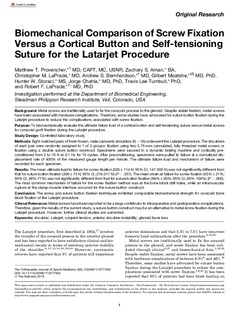| dc.contributor.author | Provencher, Matthew T. | |
| dc.contributor.author | Aman, Zachary S. | |
| dc.contributor.author | LaPrade, Christopher M. | |
| dc.contributor.author | Bernhardson, Andrew S. | |
| dc.contributor.author | Moatshe, Gilbert | |
| dc.contributor.author | Storaci, Hunter W. | |
| dc.contributor.author | Chahla, Jorge | |
| dc.contributor.author | Turnbull, Travis Lee | |
| dc.contributor.author | LaPrade, Robert F. | |
| dc.date.accessioned | 2019-05-08T10:46:14Z | |
| dc.date.available | 2019-05-08T10:46:14Z | |
| dc.date.created | 2019-01-30T08:01:48Z | |
| dc.date.issued | 2018 | |
| dc.identifier.citation | The Orthopaedic Journal of Sports Medicine. 2018, 6, 2325967118777842. | nb_NO |
| dc.identifier.issn | 2325-9671 | |
| dc.identifier.uri | http://hdl.handle.net/11250/2596961 | |
| dc.description | This open-access article is published and distributed under the Creative Commons Attribution - NonCommercial - No Derivatives License (http://creativecommons.org/licenses/by-nc-nd/4.0/), which permits the noncommercial use, distribution, and reproduction of the article in any medium, provided the original author and source are credited. You may not alter, transform, or build upon this article without the permission of the Author(s). For reprints and permission queries, please visit SAGE’s website at http://www.sagepub.com/journalsPermissions.nav. | nb_NO |
| dc.description.abstract | Background: Metal screws are traditionally used to fix the coracoid process to the glenoid. Despite stable fixation, metal screws have been associated with hardware complications. Therefore, some studies have advocated for suture button fixation during the Latarjet procedure to reduce the complications associated with screw fixation. Purpose: To biomechanically evaluate the ultimate failure load of a cortical button and self-tensioning suture versus metal screws for coracoid graft fixation during the Latarjet procedure. Study Design: Controlled laboratory study. Methods: Eight matched pairs of fresh-frozen, male cadaveric shoulders (N ¼ 16) underwent the Latarjet procedure. The shoulders of each pair were randomly assigned to 1 of 2 groups: fixation using two 3.75-mm cannulated, fully threaded metal screws or fixation using a double suture button construct. Specimens were secured in a dynamic testing machine and cyclically preconditioned from 2 to 10 N at 0.1 Hz for 10 cycles. After preconditioning, specimens were pulled to failure at a normalized displacement rate of 400% of the measured gauge length per minute. The ultimate failure load and mechanism of failure were recorded for each specimen. Results: The mean ultimate load to failure for screw fixation (226 ± 114 N; 95% CI, 147-305 N) was not significantly different from that for suture button fixation (266 ± 73 N; 95% CI, 216-317 N) (P ¼ .257). The mean strain at failure for screw fixation (63% ± 21%; 95% CI, 48%-77%) was not significantly different from that for suture button fixation (86% ± 26%; 95% CI, 69%-104%) (P ¼ .060). The most common mechanism of failure for the screw fixation method was at the bone block drill holes, while an intramuscular rupture at the clamp-muscle interface occurred for the suture button construct. Conclusion: The screw and suture button fixation techniques exhibited comparable biomechanical strength for coracoid bone block fixation of the Latarjet procedure. | nb_NO |
| dc.language.iso | eng | nb_NO |
| dc.subject | shoulder | nb_NO |
| dc.subject | Latarjet | nb_NO |
| dc.subject | conjoint tendon | nb_NO |
| dc.subject | anterior shoulder instability | nb_NO |
| dc.subject | glenoid bone loss | nb_NO |
| dc.title | Biomechanical Comparison of Screw Fixation Versus a Cortical Button and Self-tensioning Suture for the Latarjet Procedure | nb_NO |
| dc.type | Journal article | nb_NO |
| dc.type | Peer reviewed | nb_NO |
| dc.description.version | publishedVersion | nb_NO |
| dc.rights.holder | © The Author(s) 2018. | nb_NO |
| dc.source.pagenumber | 1-7 | nb_NO |
| dc.source.volume | 6 | nb_NO |
| dc.source.journal | The Orthopaedic Journal of Sports Medicine | nb_NO |
| dc.source.issue | 6 | nb_NO |
| dc.identifier.doi | 10.1177/2325967118777842 | |
| dc.identifier.cristin | 1668204 | |
| dc.description.localcode | Seksjon for idrettsmedisinske fag / Department of Sport Medicine | nb_NO |
| cristin.unitcode | 150,34,0,0 | |
| cristin.unitname | Seksjon for idrettsmedisinske fag | |
| cristin.ispublished | true | |
| cristin.fulltext | original | |
| cristin.qualitycode | 1 | |
